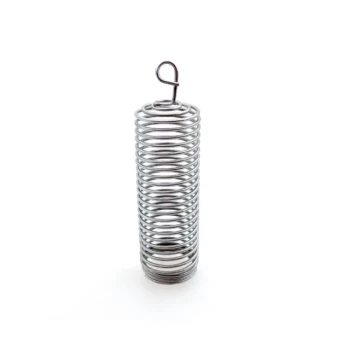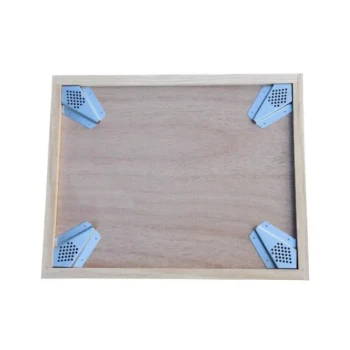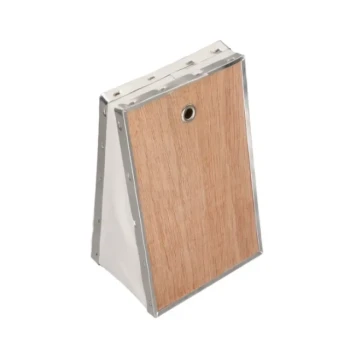To successfully raise good queens, a beekeeper must provide five critical resources: a queen mother with ideal genetics, an abundance of high-quality nectar and pollen, a large population of mature drones, suitable weather for mating, and properly configured starter and cell-builder colonies to care for the larvae.
Raising a high-quality queen is not a matter of simply following a procedure. It is about creating a microcosm of overwhelming abundance and meticulous genetic selection to guide the bees in producing a vigorous, productive, and well-mated leader for a new colony.
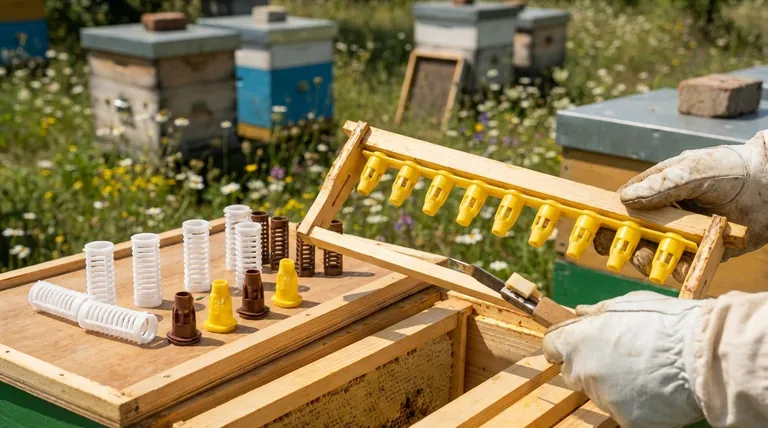
The Foundation: Genetics and Nutrition
The potential of any new queen is determined before she even hatches. It is a direct result of the genetic stock you select and the nutritional environment you provide for her development.
Selecting the Right Queen Mother
The process begins by choosing your "breeder queen" or queen mother. This hive should exhibit the exact traits you wish to propagate throughout your apiary.
Key characteristics to look for include a gentle temperament, strong disease and pest resistance, a low tendency to swarm, and excellent honey production. You are selecting the genetic blueprint for future generations.
Fueling Royal Development
A strong, continuous flow of nectar and high-quality pollen is non-negotiable. This fuels the production of royal jelly by the nurse bees.
Young larvae destined to become queens are fed royal jelly exclusively and in massive quantities. Any interruption in this rich food supply will result in smaller, less vigorous, and poorly developed queens.
The Mating Environment: Drones and Weather
Once a virgin queen emerges, her success depends entirely on factors outside the hive: the availability of mates and the conditions for her mating flight.
The Critical Role of Drones
Drones represent half of the genetic equation. A high density of sexually mature, high-quality drones is essential for a queen to mate sufficiently.
A queen mates with multiple drones on her flights. A lack of genetically diverse and healthy drones can lead to a poorly mated queen who may fail prematurely, leading to a weak or queenless colony.
The Weather Window
Queens require specific weather conditions to fly out and mate. These flights typically occur on warm, sunny, and relatively calm afternoons.
Extended periods of cold, rain, or high winds can prevent a queen from mating. If she misses this critical window (roughly two weeks after emerging), she may become a non-laying "drone layer" or fail to mate adequately, shortening her productive life.
The Hive Infrastructure for Raising Queens
Raising queens is not a task for a single hive. The process requires specialized colonies set up to perform specific jobs at each stage of development.
The Starter Colony
The first step for grafted larvae is the starter colony. This is a powerful, queenless hive packed with young nurse bees.
Their job is to "accept" the tiny larvae in the artificial queen cups and immediately begin feeding them copious amounts of royal jelly, giving them the crucial start they need.
The Cell-Building Colony
After a day in the starter, the developing queen cells are moved to a cell-building colony. This is a very strong, populous, and queenright hive.
Its sole purpose is to provide the immense resources and nurse bee population required to feed and develop the large batch of queen cells until they are capped and ready for the next stage.
The Mating Nuc
Once a queen cell is mature and close to hatching, it is transferred to a mating nucleus colony, or "nuc."
This is a small hive with a few frames of bees, brood, and food. Here, the virgin queen hatches, hardens, takes her mating flights, and begins to lay eggs, proving her viability before she is introduced to a full-sized colony.
Common Pitfalls and Trade-offs
Success in queen rearing hinges on avoiding common mistakes and understanding the limitations of different methods.
Using Swarm Cells vs. Grafting
Placing a frame with a swarm cell into a nuc is a simple way to raise a queen. However, you have no control over the genetics and may be propagating the swarming tendency.
Grafting larvae from a chosen queen mother gives you complete control over the maternal genetics, but it is a more technically demanding process that requires specialized equipment and timing.
The Risk of Poor Nutrition
Attempting to raise queens during a nectar dearth without supplemental feeding is a primary cause of failure. The bees will not have the resources to properly feed the developing larvae, resulting in subpar queens.
The "Drone Desert" Problem
Raising queens in an area with a low density of other beehives can be problematic. A lack of unrelated drones can lead to inbreeding and poorly mated queens with low genetic diversity.
Making the Right Choice for Your Goal
Your approach to raising queens should align directly with your primary objective as a beekeeper.
- If your primary focus is genetic improvement: You must learn to graft from a carefully selected queen mother to ensure desirable traits are passed on.
- If your primary focus is simply increasing hive numbers: Taking a swarm cell from a strong, productive colony is a fast and effective method for creating a new queen.
- If you are a beginner: First, master the art of keeping your colonies strong and healthy, which naturally ensures an abundance of nutrition and drones for when you are ready.
Ultimately, controlling your apiary's queen genetics is the single most powerful tool for creating a healthy, productive, and sustainable beekeeping operation.
Summary Table:
| Requirement | Key Factor | Purpose |
|---|---|---|
| Genetics | Selecting a high-quality queen mother | Determines desirable traits like productivity and disease resistance. |
| Nutrition | Abundant nectar and pollen flow | Fuels royal jelly production for vigorous queen development. |
| Mating | High density of mature drones & good weather | Ensures the queen is well-mated for a long, productive life. |
| Hive Setup | Specialized starter and cell-builder colonies | Provides the optimal environment for raising queen cells. |
Ready to elevate your queen-rearing operation? Superior queens start with superior equipment. HONESTBEE supplies commercial apiaries and beekeeping equipment distributors with the durable, high-performance supplies needed for successful grafting, cell building, and mating nuc management. Let us help you build a stronger, more productive apiary. Contact our wholesale experts today to discuss your needs.
Visual Guide
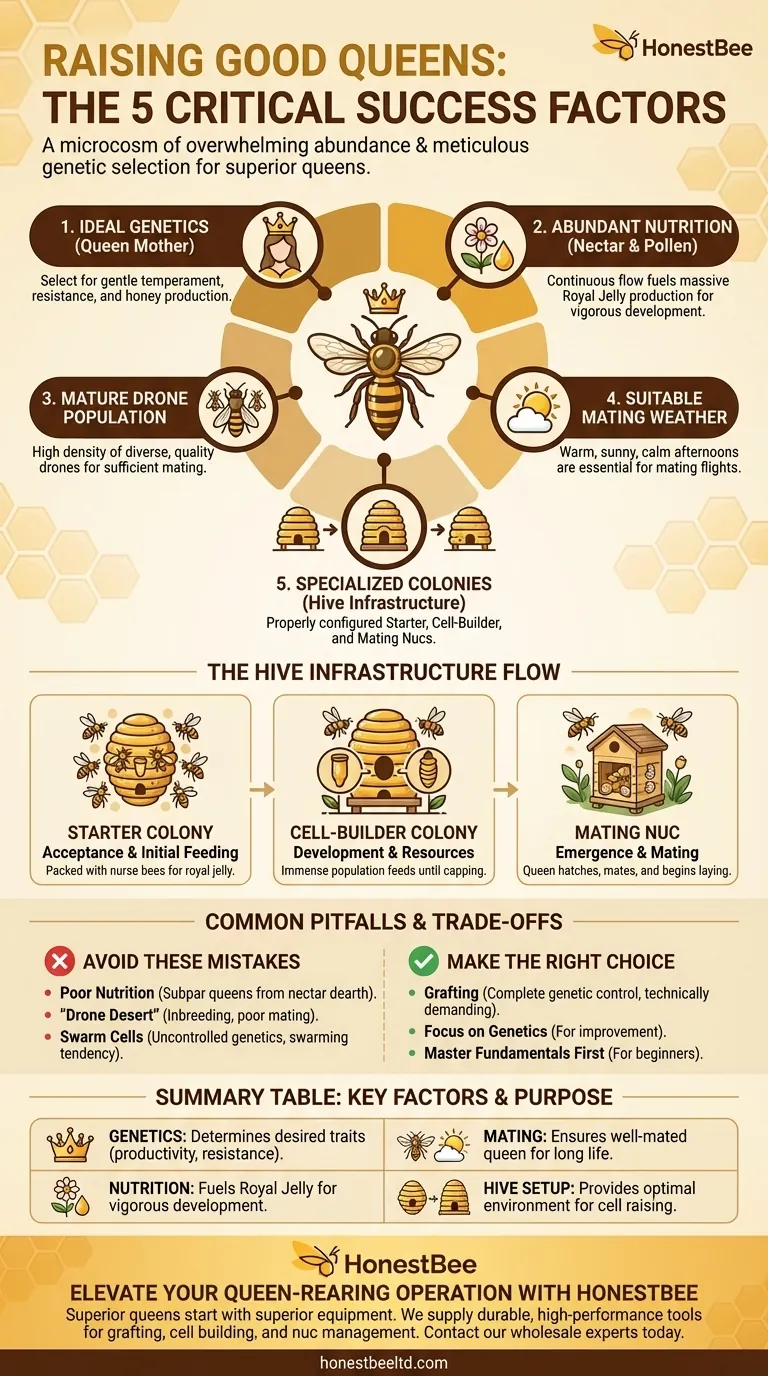
Related Products
- Jenter Queen Rearing Kit Complete Set for Bee Breeding
- No Grafting Queen Rearing Kit: System for Royal Jelly Production and Queen Rearing
- Nicot Queen Rearing Kit for Beekeeping and Grafting in Nicot System
- Durable Galvanized Steel Spring Queen Bee Cage
- Brown Nicot Queen Cell Cups for Breeding Queen Bees Beekeeping
People Also Ask
- How long does it take for a new queen to emerge, mate, and lay eggs? A Beekeeper's 10-14 Day Guide
- Why is raising queens beneficial for beekeepers? Gain Control Over Genetics and Costs
- What are the stages involved in queen raising? A Guide to Controlled, High-Quality Queen Production
- What are the implications of delayed oviposition in queen bees? A Strategy for Superior Queen Quality
- What is the timeline for queen breeding? A 28-Day Guide from Egg to Laying Queen



